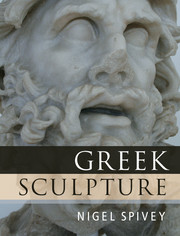Book contents
- Frontmatter
- Dedication
- Contents
- List Of Figures
- Preface
- Note
- 1 Introduction: the Study Of Greek Sculpture
- 2 The Greek Revolution
- 3 Daedalus and the Wings of Technê
- 4 Anathêmata: Gifts for the Gods
- 5 Heroes Apparent
- 6 Temple Stories
- 7 In Search of Pheidias
- 8 Revealing Aphrodite
- 9 Royal Patronage
- 10 Portraits and Personifications
- 11 Graecia Capta
- 12 Afterlife
- Index
10 - Portraits and Personifications
Published online by Cambridge University Press: 01 December 2014
- Frontmatter
- Dedication
- Contents
- List Of Figures
- Preface
- Note
- 1 Introduction: the Study Of Greek Sculpture
- 2 The Greek Revolution
- 3 Daedalus and the Wings of Technê
- 4 Anathêmata: Gifts for the Gods
- 5 Heroes Apparent
- 6 Temple Stories
- 7 In Search of Pheidias
- 8 Revealing Aphrodite
- 9 Royal Patronage
- 10 Portraits and Personifications
- 11 Graecia Capta
- 12 Afterlife
- Index
Summary
‘The mask of Socrates’
By all reports, Socrates was an odd-looking man. Even those who loved and admired the philosopher had to admit that he was strikingly bereft of conventionally handsome features. He was short and stubby in stature, with a paunch and solid neck: an apparently ignoble physique was only accentuated by Socrates’ habitual disregard for clothes and shoes. His head was large, topped by a balding dome. He had bulging eyes, a snub nose and thick lips. Half-seriously, he liked to claim some advantage from his physical nature – for instance, if his eyes protruded, was his range of vision not increased? (Xenophon, Symp. 5.3–7) – and his constitution was notoriously resilient, whether to heavy drinking or extreme cold. All the same, it made for a personal presence that his disciples described as atopos – ‘weird’, or ‘out of place’.
Some went further. ‘I say’, declares Alcibiades, ‘that he resembles nothing somuch as those Silenus-figures you see in statue-shops’ (Plato Symp. 215b). Alcibiades – stressing that he makes the analogy in the spirit of truthful candour, not mockery – then likens Socrates to Marsyas. Again this is not flattering: the story of Marsyas (see p. 287) is an unhappy tale of semi-bestial hubris, even if the satyr had a reputation as a music-teacher. But Alcibiades – himself acknowledged as winningly handsome, and athletically successful too – has a point to prove. With Socrates, what you see is not what you get. Ugly and graceless he may have appeared: but as soon as Socrates opened his mouth, it was a revelation of marvellous inner beauty. Or rather, on first hearing, the words of Socrates could seem absurd, the stuff of vulgar comedy; but when ‘opened up’ they proved utterly ‘beautiful and good’ (Plato Symp. 222a). This is a memorable contribution to the piece; and a particular portrait-type of the philosopher is traditionally associated with the Silen-image conjured by Alcibiades (Figure 10.1)
Socrates, as we have already noted (p. 35), was as guilty as anyone of making the twin assumption that good looks equated to good character, while being ‘ugly’ (aischros) should guarantee a mean and shameful nature.
- Type
- Chapter
- Information
- Greek Sculpture , pp. 248 - 275Publisher: Cambridge University PressPrint publication year: 2013



